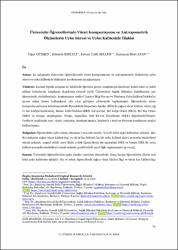Üniversite Öğrencilerinde Vücut Kompozisyonu ve Antropometrik Ölçümlerin Uyku Süresi ve Uyku Kalitesiyle İlişkisi
Abstract
Amaç: Bu çalışmada üniversite öğrencilerinde vücut kompozisyonu ve antropometrik ölçümlerin uyku
süresi ve uyku kalitesiyle ilişkisinin incelenmesi amaçlanmıştır.
Yöntem: Kesitsel tipteki çalışma bir fakültede öğrenim gören, araştırmaya katılmayı kabul eden ve dahil
edilme kriterlerini karşılayan Bandırma Onyedi Eylül Üniversitesi Sağlık Bilimleri Fakültesinin 310
öğrencisiyle yürütülmüştür. Araştırmanın verileri Tanıtıcı Bilgi Formu ve Pittsburg Uyku Kalitesi İndeksi’ni
içeren anket formu kullanılarak yüz yüze görüşme yöntemiyle toplanmıştır. Öğrencilerin vücut
kompozisyonlarının belirlenmesinde Biyoelektrik İmpedans Analizi (BİA) ile yağsız vücut kütlesi, vücut yağ
ve kas kütlesi incelenmiş, Beden Kütle İndeksi (BKİ), bel çevresi, Bel Kalça Oranı (BKO), Bel Boy Oranı
(BBO) ve triseps, supskapular, biseps, suprailiak Deri Kıvrım Kalınlıkları (DKK) değerlendirilmiştir.
Verilerin analizinde sayı, yüzde, ortalama, standart sapma, Student’s t testi ve Pearson korelasyon analizi
kullanılmıştır.
Bulgular: Öğrencilerin uyku süresi ortalama 7,10±1,66 saattir, %74,8’i kötü uyku kalitesine sahiptir. Her
iki cinsiyette yağsız vücut kütlesi (kg) ve vücut kas kütlesi (kg) ile uyku kalitesi skoru arasında istatistiksel
olarak anlamlı, negatif yönlü zayıf ilişki, erkek öğrencilerde ise suprailiak DKK ve biseps DKK ile uyku
kalitesi arasında istatistiksel olarak anlamlı, pozitif yönlü zayıf ilişki saptanmıştır (p<0,05).
Sonuç: Üniversite öğrencilerinin uyku süreleri önerilen düzeydedir, buna karşın öğrencilerin dörtte üçü
kötü uyku kalitesine sahiptir. Kız ve erkek öğrencilerde yağsız vücut kütlesi (kg) ve vücut kas kütlesi (kg) azaldıkça uyku kalitesi kötüleşmekte, erkek öğrencilerde ise suprailiak DKK ve biseps DKK arttıkça uyku
kalitesi kötüleşmektedir. Aim: In this study, it was aimed to examine the relationship between body composition and anthropometric
measurements with sleep duration and sleep quality in university students.
Method: This cross-sectional study was conducted with 310 students who studied at Faculty of Health
Sciences Bandırma Onyedi Eylul University and agreed to participate in the study and met the inclusion
criteria. The study data were collected by the face-to-face interview method using the Descriptive
Information Form, and a questionnaire including the Pittsburg Sleep Quality Index (PSQI). Body Mass Index
(BMI), waist circumference, Waist-to-Hip Ratio (WHR), Waist-to-Height Ratio (WHtR) and triceps,
subscapular, Biceps, Suprailiac Skinfold Thickness (SFT) were assessed and Bioelectric Impedance Analysis
(BIA) was used to measure lean body mass, body fat, muscle mass. Number, percentage, mean, standard
deviation, Student's t test and Pearson correlation analysis were used in the analysis of the data.
Results: The mean sleep duration of the students was 7,10±1,66 hours, and 74,8% of them had poor sleep
quality. There was a statistically significant, negative and weak relationship between lean mass (kg) and
muscle mass (kg), and sleep quality in both sexes. A statistically significant, positive and weak correlation
was determined between Suprailiac SFT and Biceps SFT, and sleep quality in the male students (p<0,05).
Conclusion: Sleep duration of the university students was at the recommended level. Three-quarters of
them had poor sleep quality. In the male and female students, the sleep quality worsened as their lean mass
(kg) and muscle mass (kg) decreased. On the other hand, in the male students, their sleep quality worsened
as the Suprailiac SFT and Biceps SFT increased.
Issue
18Collections
The following license files are associated with this item:


















